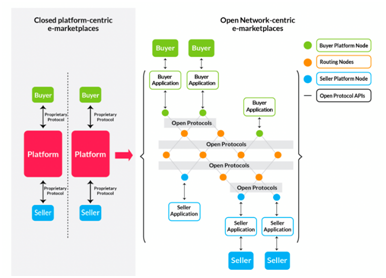"Two months in, ONDC eyes expansion into smaller cities" - The Hindu business line on 2nd December 2022.
"India's ONDC can shape the future of global ecommerce: CEO T Koshy" - Economic Times on 7th December 2022.
"ONDC requires massive efforts before it goes public, says DPIIT secy" - Business Standard on 16th December 2022.
So, what is this ONDC? How it is helpful for people in the economy? How it is different from other e-commerce giants?Here, I try to put my understanding in a simplified manner.
Introduction
ONDC is a private non-profit company (Government funded privately established start-up) established by the Department for Promotion of Industry and Internal Trade (DPIIT) of the Government of India to develop open e-commerce in the country. The operations were started as a pilot project back in April 2022 in five cities - Delhi NCR, Bengaluru, Bhopal, Shillong, and Coimbatore, now currently (as of Sep 30) live in 15 cities.
"ONDC is being established as a first-of-its-kind initiative globally to pave the way for reimagining digital commerce in India and establishing a globally replicable model for digital commerce. This will be an open network developed on open protocols based on open-source specifications with established registries, enabling wide-scale participation by digital commerce ecosystem players in India through multiple gateways." - extract from ONDC website.
Let us try decoding the above para:)
Reimagining digital commerce in India
ONDC is neither a platform nor an application; it is a network that connects buyers, sellers, and distributors for facilitating easy digital trade, with more choices for buyers and at more affordable range as this network even gives opportunities for local vendors irrespective of their size to list themselves as sellers. Unlike other e-commerce giants, ONDC functions with more transparency in trade, where buyers and sellers are easily visible and discoverable. There is no intermediary intervention in ONDC for facilitating trade, which makes it unique from other e-commerce giants.
Democratizing Digital Commerce in India
To unlock the value trapped in the ecosystem the government has come up with this initiative by not prioritising the branded goods unlike other giant e-commerce websites, but to give a way for local sellers to display their products with minimal cost.As per government, ONDC will charge 8-10% of the selling price of the product as compared to 18-40% charged by Amazon and Flipkart. The commission rate is not fixed and will be decided by the market forces. As even local merchants and vendors can register themselves as sellers on ONDC, locally manufactured goods are given importance. And the search engine analytics in other e-commerce platforms are optimised in such a way that only a specific set of players are prioritised and placed on top of the list which discourages the small players to participate in online trade,but in ONDC there is no such practice, where it makes all the sellers to equally visible through its network.
Open protocols
ONDC prioritises people's choices. For example, in ONDC the seller can decide his delivery location, refund policy, replacement policy, delivery partner and the buyer can choose his desired seller, delivery partner and can also easily browse other products sold by that seller.Hence, buyers and sellers are easily visible and discoverable leading to transparency in the trade. And as there exists many options from different vendors for a specific product, buyers get more flexibility in choosing the product in their affordable price range.

There is no protocol for a seller or a buyer to login via a fixed app or platform.Trade integration can happen through different apps/platforms. A buyer can order a product or service from any of the apps/platforms registered on the ONDC network. Similarly, a seller can participate in the trade through any of the registered apps/platforms.
Wide-scale participation
This is a decentralised network; its participants include players from various domains like grocery, food&beverages, home decor, restaurants, hotels, travel, giving scope for all the possible segments to take part in this initiative.

Here are a few differences between ONDC and existing e-commerce giants
|
ONDC |
E-commerce players |
|
It is a network for digital commerce. |
It is a platform for conduct of trade electronically. |
|
Choice in choosing sellers and delivery partners. |
No such option to choose sellers and delivery partners. |
|
Democratizing e-commerce is the main motive. |
Generating revenue is the main motive. |
|
Eliminates intermediary intervention; transparency in trade exists. |
Acts as an intermediary; no direct intervention for sellers and buyers. |
|
All kinds of vendors and merchants (Large/small/branded/unbranded) can display their products. |
Large/medium size vendors with brands are given priority. |
|
Commission charges are minimal. |
Commission charges are more when compared to ONDC. |
|
Buyers and sellers can login with different platforms. |
Buyer and seller cannot login with different apps. |
Limitations for ONDC
1. It is extremely hard to convince people to choose ONDC over trusted e-commerce giants.
2. Creating awareness regarding this new initiative is another issue.
3. Ambiguity regarding the policies on refunds; returns & replacements; parties responsible for damaged, missing product or unsatisfactory service.
4. Quality of a product or service is a concern as even the local merchants and vendors participate widely in this initiative.
Is ONDC really a game changer in e-commerce? CanONDC replace e-commerce giants? Will it succeed in bringing small vendors to e-commerce chain? Will the implementation of ONDC at a Pan India level go as planned, or will it have to face any hurdles?
There are many unanswered questions as stated above. We will have to wait and see.







 CAclubindia
CAclubindia

